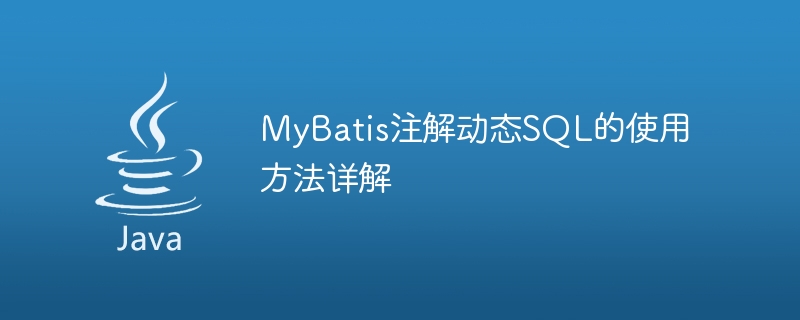Home >Java >javaTutorial >Detailed explanation of the operation steps of MyBatis annotations and dynamic SQL
Detailed explanation of the operation steps of MyBatis annotations and dynamic SQL
- 王林Original
- 2024-02-18 15:29:06964browse

Detailed explanation of the usage of MyBatis annotation dynamic SQL
Introduction to the usage of MyBatis annotation dynamic SQL
MyBatis is a persistence layer framework that provides us with Provides convenient persistence operations. In actual development, it is usually necessary to dynamically generate SQL statements based on business needs to achieve flexible data operations. MyBatis annotation dynamic SQL is designed to meet this demand. This article will introduce in detail how to use MyBatis annotation dynamic SQL and provide specific code examples.
Before using MyBatis to annotate dynamic SQL, you need to understand two key annotations: @SelectProvider and @ProviderMethod.
@SelectProvider annotation
@SelectProvider annotation is used to specify the provider of MyBatis annotation dynamic SQL. Its value attribute must specify a class that implements the dynamic SQL providing interface, usually named XXXProvider ( Such as UserProvider).
@ProviderMethod annotation
@ProviderMethod annotation is used to specify the method in the MyBatis annotation dynamic SQL provider class, which is responsible for building dynamic SQL.
The specific steps are as follows:
Step 1: Create a dynamic SQL provider class
First, we need to create a dynamic SQL provider class (that is, the class specified in the @SelectProvider annotation ), such as UserProvider. The sample code is as follows:
public class UserProvider {
public String selectUserByUsername(String username){
return new SQL(){{
SELECT("id, name, age");
FROM("user");
if(username != null){
WHERE("username = #{username}");
}
}}.toString();
}
}In the above sample code, we use the SQL class provided by MyBatis to construct the SQL statement and dynamically splice the WHERE clause through if conditional judgment.
Step 2: Add the @SelectProvider annotation
Add the @SelectProvider annotation in the Mapper interface, and specify the value attribute as the class of the dynamic SQL provider class created in step 1.
@Mapper
public interface UserMapper {
@SelectProvider(type = UserProvider.class, method = "selectUserByUsername")
List<User> selectUserByUsername(@Param("username") String username);
}Step 3: Call the dynamic SQL method
In the business logic, directly call the method defined in the Mapper interface and pass in the parameters.
List<User> userList = userMapper.selectUserByUsername("foo");Through the above three steps, we can use dynamic SQL in MyBatis. Through dynamic SQL, we can more flexibly generate different SQL statements according to business needs, improving the maintainability and scalability of the system.
Summary:
This article details the use of MyBatis annotation dynamic SQL and provides specific code examples. In actual development, dynamically generating SQL according to business needs is an important technology, and MyBatis annotation dynamic SQL is a convenient way to meet this need. I hope this article can help you understand and use MyBatis annotation dynamic SQL.
Article word count: 428
The above is the detailed content of Detailed explanation of the operation steps of MyBatis annotations and dynamic SQL. For more information, please follow other related articles on the PHP Chinese website!

